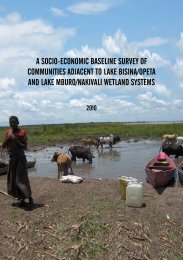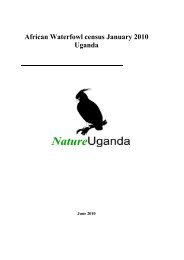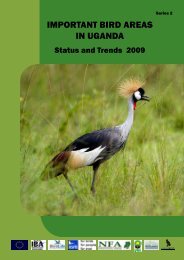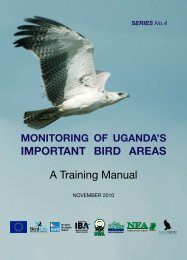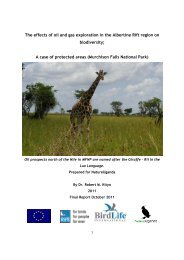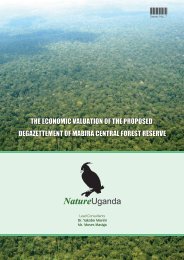A Ecological Baseline Surveys Of: - Lake Bisina - Nature Uganda
A Ecological Baseline Surveys Of: - Lake Bisina - Nature Uganda
A Ecological Baseline Surveys Of: - Lake Bisina - Nature Uganda
You also want an ePaper? Increase the reach of your titles
YUMPU automatically turns print PDFs into web optimized ePapers that Google loves.
A total of 194 species of birds were recorded during the 14 counts conducted within the Mburo-<br />
Nakivale wetland system. These included 30 migratory species and 22 species of conservation<br />
concern. Three forest specialists and 27 forest generalists were recorded (Table 1). Although the<br />
majority of species recorded were wetland species and forest visitors, three forest specialists<br />
Grey-Headed Sunbird (Deleornis axillaries), Olive Sunbird (Cyanomitra olivacea) and Black Cuckoo<br />
(Cuculus clamosus) were also recorded (Table 1).<br />
Table 1: Species recorded in the different habitat and migratory classes<br />
in the Mburo-Nakivale wetland system<br />
Habitat Number of species<br />
FF 3<br />
F 27<br />
f 46<br />
W 62<br />
G 16<br />
Migration<br />
A 11<br />
P 19<br />
The migratory species included 11 Afro-tropical and 19 Palearctic migrants. Among the species of<br />
conservation concern, we had one globally and regionally vulnerable species the Shoebill (Balaeniceps<br />
rex), one globally vulnerable and regionally near-threatened species the Grey Crowned Crane<br />
(Balearica regulorum), one globally and regionally near-threatened species African White-backed<br />
Vulture (Gyps africanus), three globally near-threatened species the Papyrus Gonolek (Laniarius<br />
mufumbiri), Bateleur (Terathopius ecaudatus) and Sooty Falcon (Falco concolor), one regionally<br />
vulnerable species the Great White Egret (Casmerodius alba), five regionally near-threatened species<br />
the Grey Heron (Ardea cinerea), Woolly-Necked Stork (Ciconia episcopus), Rufous-Bellied Heron<br />
(Ardeola rufiventris), African Marsh Harrier (Circus ranivorus) and Brown Snake-Eagle (Circaetus<br />
cinereus) and ten species with regional responsibility (Table 2).<br />
The most abundant species were the Blue-Cheeked Bee-Eater Merops persicus, Grey-Headed<br />
Sunbird Deleornis axillaries, Klaas’ Cuckoo Chrysococcyx klaas, Yellow-Fronted Tinkerbird<br />
Pogoniulus chrysoconus, Cardinal Woodpecker Dendropicos fuscescens and Red-Billed Firefinch<br />
Lagonosticta senegala each with a relative abundance of six (Appendix 1).<br />
The results show that a significant number of species was recorded in the sensitive species classes<br />
which include the migrants, species of conservation concern and forest specialists. These species<br />
are usually regarded as the indicator species for habitat environmental health. The presence of these<br />
sensitive species in the area indicates that this wetland is very important in the conservation of the<br />
birds in the country and the world as a whole due to the presence of migrants. The conservation<br />
plan of this area should put into consideration the habitats of these species and ensure that they<br />
are conserved for the survival of the regional as well as the global populations.<br />
<strong>Ecological</strong> <strong>Baseline</strong> <strong>Surveys</strong> of <strong>Lake</strong> <strong>Bisina</strong>, <strong>Lake</strong> Opeta, <strong>Lake</strong> Mburo and Nakivali Wetlands Systems 11



